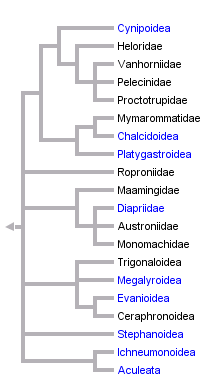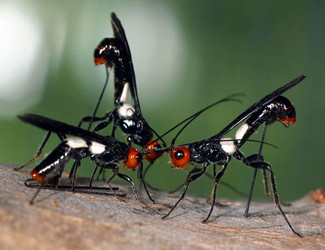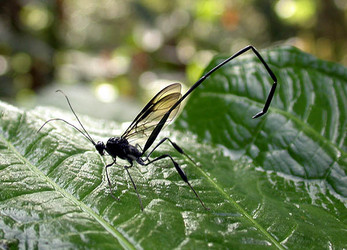Apocrita
Wasps



This tree diagram shows the relationships between several groups of organisms.
The root of the current tree connects the organisms featured in this tree to their containing group and the rest of the Tree of Life. The basal branching point in the tree represents the ancestor of the other groups in the tree. This ancestor diversified over time into several descendent subgroups, which are represented as internal nodes and terminal taxa to the right.

You can click on the root to travel down the Tree of Life all the way to the root of all Life, and you can click on the names of descendent subgroups to travel up the Tree of Life all the way to individual species.
For more information on ToL tree formatting, please see Interpreting the Tree or Classification. To learn more about phylogenetic trees, please visit our Phylogenetic Biology pages.
close boxReferences
Boucek, Z. 1988. Australasian Chalcidoidea (Hymenoptera): a biosystematic revision of genera of fourteen families, with a reclassification of species. C.A.B. International, Oxon.
Brothers, D.J. 1975. Phylogeny and classification of the aculeate Hymenoptera, with special reference to Mutillidae. Kans. Univ. Sci. Bull. 50:483-648.
Carpenter, J. M. 1987. On the evolutionary genetics of social wasps and the phylogeny of the Vespinae (Hymenoptera, Vespidae). Insectes Sociaux 34(1):58-64.
Dowton, M. and A. D. Austin. 1994. Molecular phylogeny of the insect order Hymenoptera: Apocritan relationships. Proc. Natl. Acad. Sci. USA 91:9911-9915.
Dowton, M. and A. D. Austin. 2001. Simultaneous analysis of 16S, 28S, COI and morphology in the Hymenoptera: Apocrita - evolutionary transitions among parasitic wasps. Biological Journal of the Linnean Society 74:87-111.
Fergusson, N. D. M. 1988. A comparative study of the structures of phylogenetic importance of female genitalia of the Cynipoidea (Hymenoptera). Systematic Entomology 13(1):13-30.
Gibson, G.A.P. 1986. Evidence for the monophyly and relationships of Chalcidoidea, Mymaridae, and Mymarommatidae (Hymenoptera: Terebrantes). Can. Ent. 118:205-240.
Leluk, J., J. Schmidt, et al. 1989. Comparative studies on the protein composition of hymenopteran venom reservoirs. Toxicon 27(1):105-114.
Plant, J. D. and H. F. Paulus. 1987. Comparative morphology of the postmentum of bees (Hymenoptera: Apoidea) with special remarks on the evolution of the lorum. Zeitschrift Fuer Zoologische Systematik Und Evolutionsforschung 25(2):81-103.
Saini, M. S. 1986. Comparative studies on the metapostnotal modifications in suborder Symphyta and Hymenoptera Parasitica. Journal Of Entomological Research 10(1):85-90.
Schmidt, J. O., M. S. Blum, et al. 1986. Comparative enzymology of venoms from stinging Hymenoptera. Toxicon 24(9):907-922.
Schoenitzer, K. and G. Lawitzky. 1987. A phylogenetic study of the antenna cleaner in Formicidae, Mutillidae, and Tiphiidae (Insecta, Hymenoptera). Zoomorphology 107(5):273-286.
Sharkey, M. J. and A. Roy. 2002. Phylogeny of the Hymenoptera: a reanalysis of the Ronquist et al. (1999) reanalysis, emphasizing wing venation and apocritan relationships. Zoologica Scripta 31:57-66.
Whitfield, J. B., N. F. Johnson, et al. 1989. Identity and phylogenetic significance of the metapostnotum in nonaculeate Hymenoptera. Annals Of The Entomological Society Of America 82(6):663-673.
Whitfield, J.B. 1998. Phylogeny and evolution of host-parasitoid interactions in Hymenoptera. Annual Review of Entomology, 43:129-151.
Title Illustrations

| Scientific Name | Syngaster lepidus |
|---|---|
| Acknowledgements | Photograph courtesy InsectImages.org (#1295001) |
| Specimen Condition | Live Specimen |
| Sex | Female |
| Source Collection | Bugwood Network/Forestry Images |
| Copyright | © Dong-Hwan Choe, University of California |
| Scientific Name | Pelecinus sp. (Pelecinidae) |
|---|---|
| Location | Cotopaxi, Ecuador |
| Specimen Condition | Live Specimen |
| Sex | Female |
| Copyright |
© 2003 Alex Wild

|
About This Page
Page copyright © 1995
All Rights Reserved.
Citing this page:
Tree of Life Web Project. 1995. Apocrita. Wasps. Version 01 January 1995 (temporary). http://tolweb.org/Apocrita/11162/1995.01.01 in The Tree of Life Web Project, http://tolweb.org/









 Go to quick links
Go to quick search
Go to navigation for this section of the ToL site
Go to detailed links for the ToL site
Go to quick links
Go to quick search
Go to navigation for this section of the ToL site
Go to detailed links for the ToL site